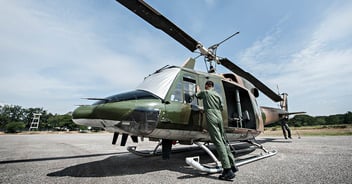
Heli Expo 2022: Top 5 Business enablers that Helicopter industry may ask for
Published :

In few days, shutters will be open for the world’s largest Helicopter show, HAI HELI EXPO 2022 at Dallas. The entire Heli community right from OEMs, operators, MROs, suppliers, software firms and enthusiasts will congregate at The Kay Bailey Hutchison Convention Center. While this show has been going on for decades, this year’s show would be quite different from the earlier ones as it is happening right after the pandemic forced HAI to cancel its 2021 show. A lot has changed in these two years and it definitely is not business as usual. Based on our interaction with the leaders in the industry, below are some of the key asks of the industry from their technology partners
Having real-time visibility into aircraft and fleet readiness is one of the key factors in determining how many aircraft are fully mission-ready, partially mission-ready and non-mission ready. The ability to check the real-time fleet status by considering the downstream maintenance activities and schedule planned is very much the need of the hour.
This information will help operators to keep track of SLAs with end customers and also help in making instant decision to dispatch the aircraft as per customers’ critical requirements.
Realtime visibility works only when different departments can talk to each other. For example, the interactions between pilots and mechanics. A robust Electronic Flight Bag (EFB) allows the pilots to review the flight manifest, perform weight and balance calculations, manage inflight documents and checklists, and record logbook in a fully electronic mode. Squawks can also be recorded by the pilots and if they have check ratings, then pilots can electronically sign-off the inspection item within the application. The system should enable the data captured by the pilots to be immediately visible to the ground team and mechanics. Similarly, pilots should be able to get visibility into maintenance status without manual communication.
Safety is non-negotiable! The technology in place should provide the ability to do risk assessment in real-time and electronic mode. Crew should be able to self-evaluate and in case of high-risk cases, it automatically routes to the OCC for further approval. The system should also check if the pilot has enough duty time available to proceed with the mission. And needs to allow the crew to report the duty time and validate their currency information.
Matching the right crew to the right aircraft at right time will ensure a lot of operational efficiencies. Technology needs to provide the right recommendation of crew and also help dispatch the correct aircraft which will reduce the overall downtime in dispatching the aircraft and also ensure that the right crew members are assigned.
A robust roaster management capability that allows customers to manage the complete schedule of flight crews and manage the assignments in a fully automated way is the need of the hour. Such a system ensures that the crew has the right duty time available as per regulatory requirements and roasters the crew for the future missions. This way, the dispatch team can actually look at the crew and assign the right crew for mission requirements. This will ensure the customer has visibility into the crew available for a given mission and there is no delay due to crew non-availability.
Timely and accurate billing is key to customer satisfaction. The end-to-end billing process where the customer can define the flight charter, contract terms & conditions in the contract framework. Anytime when a pilot records their journey log entry, the system automatically evaluates the contract and then generates the flight sheet as per contract terms and conditions. And this needs to happen in a real-time basis where, once the mission is done, the customer instantly has the data gathered and it needs to be ready for billing. Since the billing information is available both electronically and instantly shared with customers, overall cash flow increases and ensures there are no revenue leakages due to under-billing and customer dissatisfaction due to over-billing.
To summarize, the onus on digital technologies has increased multi-fold in the Heli industry. From being a niche differentiator, technology is moving to become a must-have to stay relevant and ensure operational efficiencies for Heli Operators. It will be interesting to watch how industry partners take the cue.

All Rights Reserved. © Copyright 2024. Ramco Systems.